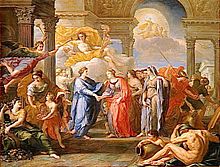Arnould de Vuez
Arnould de Vuez (born March 10, 1642 in Saint-Omer (Pas-de-Calais), † April 3, 1724 in Saint-André-lez-Lille ) was a French painter .
Life
Arnould de Vuez was the eldest of ten siblings and his father, who was born in Verona and was actually a metal turner, served as a soldier. Arnould left his place of birth for Paris in 1657 to perfect his painting technique in the studio of Luc, a Franciscan monk . Then he moved to his uncle, a canon in Venice and later to Rome , where he received a first prize in 1661 for one of his drawings at the Accademia di San Luca .
Since he killed his opponent in a duel, he had to flee to Paris. There Arnould worked in the studio of Charles Le Brun at the court of Louis XIV . The Notre Dame Church in Paris commissioned Arnould to paint “ The Incredible Thomas ”, which has been in the Saint-Jean de Lyon cathedral since the French Revolution . He stayed for about a year (in the 1670s) with the French envoy Charles Olier de Nointel in Constantinople, after which he returned to Paris.
After Le Brun's death in 1690, de Vuez settled in Saint-André-lez-Lille, where he died in 1724. Since the conquest of Louis XIV, the city has been rebuilt and Arnould de Vuez received commissions from religious institutions in the city and its surroundings, including the Comtesse and Carmelite Hospice in Lille, the Carmelites in Douai , the Benedictines in Marchiennes and the Jesuits in Cambrai .
His style was strongly influenced by the Italian Renaissance and modeled on the color sense of Flemish artists such as Rubens and Anthony van Dyck .
In 2018 de Vuez was' about 3 × 6 meters large painting Marquis de Nointel reached Jerusalem , which de Vuez had painted in 1674, in good condition behind the wall of a Paris Appartementes during the transformation to an Oscar de la Renta -Boutique discovered . The presumption is that it was glued to the wall and then covered to protect it from the Nazis , who occupied the city of Paris from 1940 to 1944 during World War II and expropriated works of art on a large scale.
The Rue de Arnould-de-Vuez in Lille is named after him.
Works (selection)
- Allegory of the wedding of Louis de Bourbon, Dauphin de Viennois with Maria Anna Victoria of Bavaria , de Vuez's academy work
- Annunciation , Saint-André church, Lille
- Saint Zita , (1696), Musée des Beaux-Arts, Lille
- The incredulous Thomas , Lyon Cathedral
- The St. Cecilia accompanied by three angels playing instruments , Musee des Beaux-Arts, Lille
- Adoration of the Shepherds , Saint-Etienne Church, Lille
- Mourning Virgin Mary , Musée des Beaux-Arts, Lille
- Francis of Assisi receiving the stigmata , Musée des Beaux-Arts, Lille
- Baldwin V of Hainaut and Margaret I of Flanders , Musée de l'Hospice Comtesse, Lille
- Charles the Bold , Musée de l'Hospice Comtesse, Lille
- Karitas , Musée de l'Hospice Comtesse, Lille
- Faith , Musée de l'Hospice Comtesse, Lille
- Ursula of Cologne | Martyrdom of St. Ursula , Musée de l'Hospice Comtesse, Lille
- Virgin Mary , Musée de l'Hospice Comtesse, Lille
- Assumption of the Virgin Mary , Musée de l'Hospice Comtesse, Lille
- Mary of Burgundy , (wife of Emperor Maximilian I ), Musée de l'Hospice Comtesse, Lille
Exhibitions
- Lille au XVIIème siècle. , 2000, Musée des Beaux Arts de Lille.
literature
- JD Fiorillo: History of the Drawing Arts from their Revival to the Most Recent Times; Third volume. containing the history of painting in France. JF Röwer, Göttingen 1805, p. 285.
- o. A .: General artist lexicon, or a short message from the life and works of painters, sculptors, builders, copper engravers, art founders, steel cutters, etc., Part Two, Section ninth. Orell, Füßli and Compagnie, Zurich 1816, p. 4055.
- o. A .: Biography Universelle. Volume 49, LG Michaud, Paris 1827, p. 590.
- Hector Beaurepaire Piers: Biography de la ville de Saint-Omer: Avec portraits. JB Lemaire, Saint-Omer 1835, pp. 93ff.
- Louis Quarré-Reybourbon: Arnould de Vuez, peintre lillois, 1644-1720. Lefebvre-Ducrocq, Lille 1904.
- Laurence Quinchon-Adam: Arnould de Vuez: 1644-1720 sa peinture flamande. 1985.
- Colum Hourihane: The Grove Encyclopedia of Medieval Art and Architecture. Volume 1, Oxford University Press, Oxford 2012, pp. 68f.
Individual evidence
| personal data | |
|---|---|
| SURNAME | Vuez, Arnould de |
| BRIEF DESCRIPTION | French painter |
| DATE OF BIRTH | March 10, 1642 |
| PLACE OF BIRTH | Saint-Omer (Pas-de-Calais) |
| DATE OF DEATH | April 3, 1724 |
| Place of death | Saint-André-lez-Lille |


